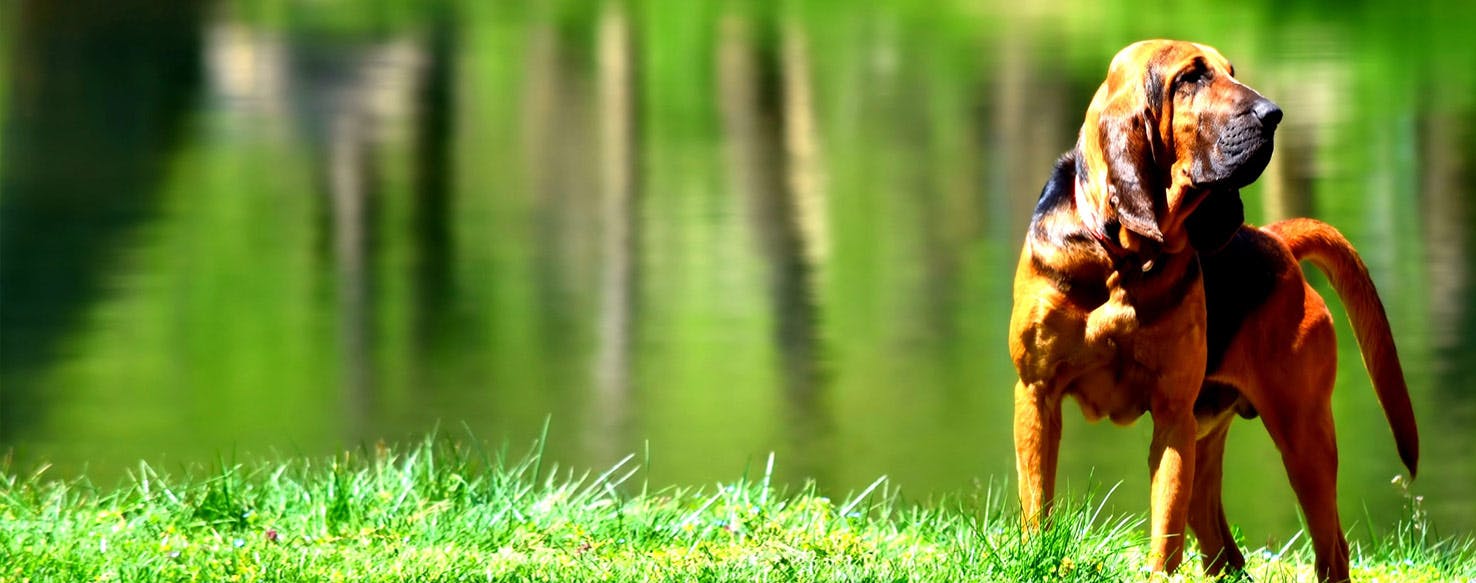- Home
- The Daily Wag!
- Behavior
- Why Do Bloodhounds Cry

Common
Normal
There is little that’s more endearing or adorable than a Bloodhound’s big, soulful eyes staring up into yours. Bloodhound puppies can melt the hardest of hearts with their attempts at the classic Bloodhound bay, but when your Bloodhound gets older their cry can become less adorable and more annoying. Some Bloodhounds may howl incessantly, baying for hours and crying at the drop of a hat. Others may only cry at night, or when they’re denied the ability to chase a scent that they find particularly interesting. But why do Bloodhounds do this? What is the reason behind their cry? What makes the difference between a Bloodhound that cries when it’s important and one that whines to hear their own voice? We’re going to talk about that.
As trailing dogs, Bloodhounds are known for their distinctive howls, cries, and bays when following the scent of something exciting. But even Bloodhounds who don’t hunt still have the same sounds hard-wired into their personality. Because Bloodhounds are large, energetic dogs who are used to a lot of exercise, your Bloodhound may howl because of boredom or pent-up energy that they need to work out. If your Bloodhound is outside and you find them crying at the edge of your fence (because fences are a must for these single-minded pups), it’s possible that they’ve lit upon a scent they want to chase down and have been stopped. It’s also possible that they’ve smelled another dog and they want to be friends! Bloodhounds are extremely social, as they’re pack animals, and they’ll easily and gladly incorporate you into their family. That being said, they’re not an animal that does well being left alone for long periods of time, as they can develop separation anxiety and loneliness. Both of these will cause your Bloodhound to cry and howl in an attempt to get your attention or try to call you back.
And of course, Bloodhounds will cry for many of the same reasons that other dog breeds cry; if they’re experiencing stress, anxiety, pain, or even excitement. Bloodhounds and other hunting and tracking breeds are even more prone to these types of vocalizations than others because they’re used to vocalizing about everything! As puppies and adolescents, your Bloodhound may cry more often than a mature dog. They’re learning how to cry, howl, and bay, and because Bloodhounds take longer to come to full maturity than some other breeds, they may exhibit this kind of behavior despite training and activity. Bloodhounds, while gentle and loving, can also be stubborn and independent. If they notice that you’re giving them attention – even potentially negative attention – for crying, it may encourage them to cry more, especially before they’re fully grown.
Need advice about your pet's health?
Get answers fast from a veterinary professional 24/7 in the Wag! App.
Get Vet ChatWhether or not you want to encourage your Bloodhound’s cry is dependent on how you intend to use your Bloodhound. If you’ve gotten a Bloodhound to be a working or trailing dog, then it’s important to train them to use their cry at the right moment, such as when they’ve caught onto a scent or when they’ve detected danger. Bloodhounds can be somewhat difficult to train due to their determination and stubbornness when it comes to tracking a scent or focusing on an activity. Positive reinforcement is a great way to get to your Bloodhound’s heart and help them learn appropriate tracking and working behaviors.
If you’re getting a Bloodhound as a pet for your home, it’s imperative to keep them entertained. A tired Bloodhound makes for a happy owner – make sure you have a fenced-in yard that they can play in and take them on long walks to indulge their desire for tracking. A bored Bloodhound is going to howl and cry because of their pent-up energy and may even turn to destructive habits. Training is also key here. Reward your pup when they don’t react to triggers like doorbells or strangers with howling and crying. Give them lots of attention and love when they’re behaving appropriately, reinforcing their desire to be with you and make you happy. Both your family and your neighbors will thank you!
If you find that your Bloodhound is still crying even after exercise and proper training, you may want to take them to the vet. Whether your pooch is suffering from anxiety or one of the many health conditions that can impact their life – like hip dysplasia or fold dermatitis – the vet will be able to help ensure that your Bloodhound gets back to full, happy health. This should correlate with a drop in the baying, crying, and howling; your faithful friend has gotten the attention they need and is feeling better. If you have an older dog, it’s also important to be patient. Some older dogs experience degrees of dementia, and may cry or howl because they’re scared, confused, or simply don’t know what’s going on. If this is the case, you should give them as much love and reassurance as possible, to help reduce their crying and keep them comfortable and safe.
Bloodhounds bay – it’s in their blood! But with some training and work, you can help your Bloodhound cry at appropriate times, or keep them from crying too much at home. Just keep your dog active, give them lots of love, and, if possible, find them a companion to play with. When your Bloodhound is happy and fulfilled, they’re less likely to cry for no reason, and more likely to be a joy to you, your family, and your friends.
Written by a Poodle lover Sarah Jeter
Veterinary reviewed by:
Published: 04/26/2018, edited: 01/30/2020
More articles by Sarah Jeter

